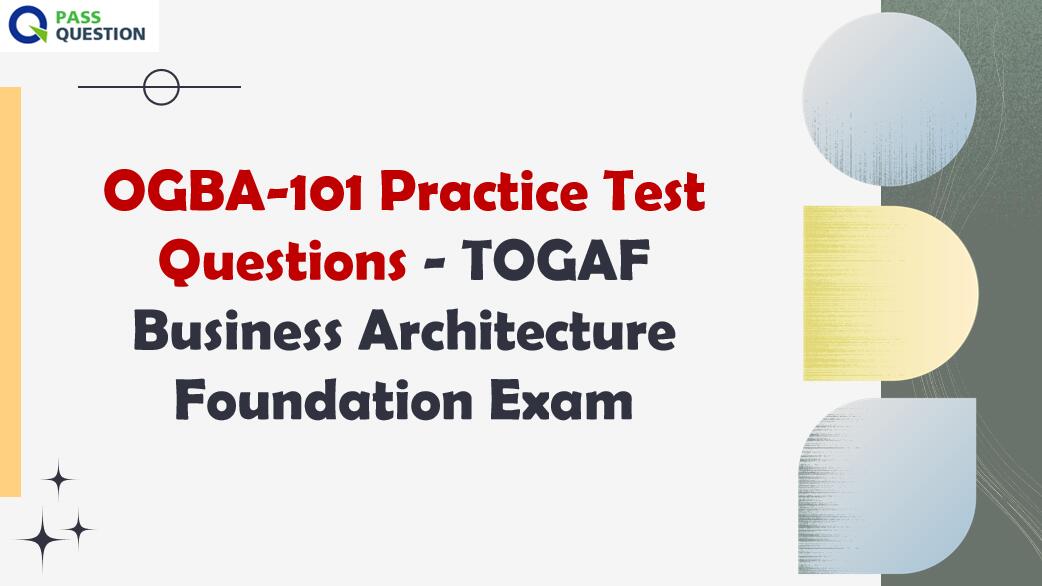OGBA-101 Practice Test Questions - TOGAF Business Architecture Foundation Exam
To assist you in the most efficient and thorough manner to adequately get ready for the TOGAF Business Architecture Foundation Exam, we strongly suggest that you make use of PassQuestion OGBA-101 Practice Test Questions in order to optimize your exam preparation. you will not only have the opportunity to expand your existing knowledge and improve your skills but also enhance your understanding and grasp of the subject matter. By thoroughly studying these extensive OGBA-101 Practice Test Questions, you will have the opportunity to expand your knowledge and improve your skills, guaranteeing that you are fully prepared to confidently and effortlessly pass your exam.

TOGAF Business Architecture Foundation Exam
This exam consists of 40 questions presented in a simple multiple-choice format. It covers the Level 1 learning outcomes, which can be found in detail in the Conformance Requirements. For each correct answer, one point is awarded. To pass the exam, a minimum of 60% is required, which means answering 24 or more questions correctly out of the total of 40. By earning this badge, individuals demonstrate their knowledge of the TOGAF Standard approach and their understanding of TOGAF Business Architecture concepts and techniques. They possess the following competencies:
1. The ability to develop and maintain a TOGAF Business Architecture.
2. The skill to utilize TOGAF Business Architecture techniques to facilitate controlled organizational changes.
3. Proficiency in applying TOGAF Business Architecture techniques.
Exam Summary
Exam Name: TOGAF Business Architecture Foundation Exam
Exam Number: OGBA-101 - English
Qualification upon passing: TOGAF Business Architecture Foundation
Body of Knowledge: Based on the TOGAF Standard, 10th Edition
Delivered at: Authorized Examination Provider Test Centers, or take remotely via OnVUE Online Proctored
Exam type: Multiple choice
Number of questions: 40
Pass score: 60% (24 out of 40 questions)
Time limit: 60 minutes (*)
Study Tips to Prepare for the TOGAF Business Architecture Foundation Exam
Here are some study tips to prepare for the TOGAF Business Architecture Foundation Exam:
1. Familiarize yourself with the TOGAF Standard: Read and understand the TOGAF Standard, 10th Edition, which forms the basis of the exam. Pay attention to the business architecture concepts and techniques covered in the exam.
2. Review the Conformance Requirements: The Level 1 learning outcomes and Conformance Requirements provide a detailed breakdown of the topics and areas that will be covered in the exam. Make sure you understand each requirement and study accordingly.
3. Practice with sample questions: Find sample questions similar to those in the exam and practice answering them. This will help you become familiar with the format and types of questions you may encounter.
4. Utilize study resources: Use study guides, textbooks, online courses, and other resources to supplement your learning. These resources can provide additional explanations and examples to enhance your understanding.
5. Join study groups or forums: Engage with other individuals preparing for the exam. Discussing topics, sharing insights, and asking and answering questions can deepen your understanding and provide different perspectives.
6. Create a study plan: Plan your study sessions and allocate dedicated time for each topic. Breaking down your study into manageable chunks will help you stay organized and focused.
7. Take mock exams: Simulate exam conditions by taking mock exams. This will help you assess your knowledge and identify areas that need further improvement.
8. Review and revise: Regularly review the topics you have studied and revise key concepts. Reinforce your understanding by summarizing information, creating flashcards, or teaching the material to someone else.
View Online TOGAF Business Architecture Foundation OGBA-101 Free Questions
1. Which approach to model, measure, and analyze business value is primarily concerned with identifying the participants involved in creating and delivering value?
A.Value chains
B.Value networks
C.Lean value streams
D.Value streams
Answer: B
2. What is defined as the effect of uncertainty on objectives?
A.Threat
B.Continuity
C.Risk
D.Vulnerability
Answer: C
3. Consider the following:
In Phase A a business capability map and a core set of value streams were created while developing the Architecture Vision.
Why would such Architecture Descriptions need to be updated in Phase B?
A.Phase B requires that all Architecture Descriptions be updated.
B.The development of Business Architecture Descriptions is always iterative.
C.Phase B is an ADM Architecture Development phase.
D.A new value stream was assessed as in the project scope.
Answer: B
4. Which of the following best describes a TOGAF business scenario?
A.A business case.
B.A technique to elaborate an architecture effort.
C.A method to develop a business model.
D.A use-case providing detailed descriptions.
Answer: B
5. Which statement best describes iteration and the ADM?
A.The ADM is sequential. Iteration is applied within phases.
B.The ADM is iterative between phases B to D, and between Phases E and F.
C.The ADM is iterative, over the whole process, between phases, and within phases.
D.The level of detail is defined once and applies to all iterations.
Answer: C
6. Which of the following is the element of a value stream stage that describes the state change that triggers the value stream stage?
A.Baseline state
B.Enhance criteria
C.Starting point
D.Gating stage
Answer: C
7. Which of the following is a benefit of information mapping?
A.It enables improved business process integration.
B.It provides a framework for effective business requirements analysis.
C.It highlights information requirements not addressed by a business architecture.
D.It provides a basis to support decision-making throughout the business.
Answer: D
8. Which of the following is guidance for creating value streams?
A.Start with customer-based value streams.
B.Identify the top-level value streams from components of capabilities.
C.Create an initial set of value streams that map one-to-one to existing capabilities.
D.Include operational levels of detail.
Answer: A
- TOP 50 Exam Questions
-
Exam
All copyrights reserved 2025 PassQuestion NETWORK CO.,LIMITED. All Rights Reserved.

